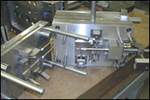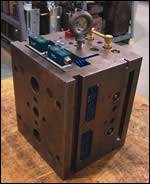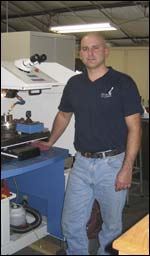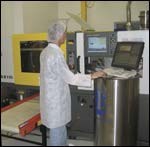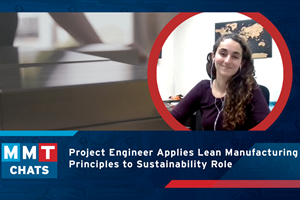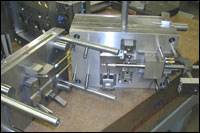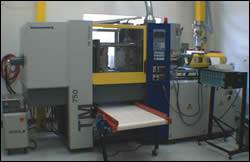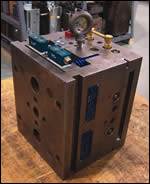Extreme Tool and Engineering: Building Relationships, Fostering Growth
This moldmaker proves that dedication to its customers combined with a will to thrive in a global marketplace is the right formula to win the MoldMaking Technology 2006 Leadtime Leader Award: Large Shop.
- Packaging
- Workforce Development
- Machining
- Additive Manufacturing
- Five Axis
- Maintenance & Repair
- Build
- Marketing
- Manage
- EDM
- Maintain
- Regulations
- Business Strategy
- Consumer
- Inspection & Measurement
- Automation
- Surface Treatment
- Engineer
- Leadtime Leader
- Medical
- Case Study
- Grinding
- Automotive
- Mold Materials
- Hot Runners
- Design & Mfg. Software
- electronics
Nearly eight years ago, Extreme Tool and Engineering (Wakefield, MI)—a manufacturer of pre-production molds, Class 101 production tooling, hot runner molds, auto unscrewing molds, insert molds and manual transfer two-shot over-molds—formed with just six employees and a dream to grow into a full-service, art-to-part, product development firm. President Mike Zacharias has been living out this dream with his 50-plus employees—experiencing an amazing 100 percent growth in 2004, and 20 percent last year with average leadtimes of four to six weeks for 1,000-1,500 Class 101 production tooling and two to four weeks for pre-production tooling.
Primarily catering to the automotive, consumer goods, electronics, medical and telecommunications industries, Extreme Tool’s annual sales reached $7 million last year with its small but diverse customer base. A vital component of reaching this impressive sales figure has been the company’s savvy management of its budget. For example, Zacharias calculates overhead based on a factor of the non direct labor related costs divided by the billable and manufacturing hours on an annual basis. Cost over-runs are a more complex issue. “Over-runs are always unsettling, but I always try to make big picture/long term decisions rather than dealing with it from the point of least pain at present,” he explains. “Generally, we try to do what is right/best for the long-term interests of the customers. I do not believe in cutting corners for the sake of reducing short-term pain/financial consequence. Our business has built its reputation based on standing behind our work—independent of short term cost implication—and many of our best relationships have been built on this foundation. Costs as they relate to non-productive work are treated the same. We are in a constant state of relationship-building with every customer, and our decisions are based on aligning ourselves with customers that stand a good opportunity to be a contributing part of our business long-term, and then invest in that customer as needed.”
Zacharias also credits the company’s success to concurrent engineering and manufacturing processes with a team-structured, 24/7 operation coupled with its entrance into the global marketplace. Currently the company exports 30 to 35 percent of its molds to Mexico, Asia, Hungary, Denmark and Brazil. “We have nine sets of Pro/Engineer, and it is used for all aspects of the mold design and manufacturing process—including product design assistance, mold design, electrode design, CNC programming, CMM programming and Mold Flow,” Zacharias states. “Using one system for all operations is critical in reducing leadtimes.”
The company provides “cradle-to-grave” plastic product development services whenever its customers desire. “We sell a service—not a product—and every aspect of plastic product development that we offer is another opportunity to add value to the service we sell,” he states. “At an ESI (Early Supplier Involvement) stage, we help many customers with product design/design for manufacturing. We are not product designers—and do not wish to be—but we do understand molding and toolmaking and can help ensure a customer’s product design is really ready for the molding process.”
Outermost Origins
Extreme Tool and Engineering was formed in July 1998 when the assets of their former employer—Global Tool and Engineering—were purchased and the new company, Extreme Tool and Engineering, became a reality. Zacharias had been running two divisions of Global, so he already knew the ins and outs of the shop and was eager to take the reins of this new venture.
As for the origin of the new company name, Zacharias first points out the company’s extreme location in far northern Michigan’s Upper Peninsula (U.P.)—with an average annual snowfall of more than 200 inches. “Our location is driven primarily by our strongest resource—our personnel. Our people have always been the biggest thing separating our company from our peers. Many of our best employees were born and raised in our area, and are dedicated to seeing our company succeed because they do not wish to leave. Our turnover is very low, which is very important to our success as well. As we seek additional new employees, many experienced individuals are attracted to the lifestyle our area offers, while still working for a progressive/technology-driven corporation. Our location offers clean air, clean water, a multitude of recreational opportunities, and a very safe/family friendly location to raise a family. Having said all that, we do have an airport located 15 miles from our facility that allows customers from all over the world to travel to our location regularly with relative ease. We often take our customers snowmobiling after a successful mold sample or conduct meetings while fishing or gathering around a campfire. We also have a T1 data line into our plant, which is a crucial link to the data world we live in. Lastly, we are located in a Michigan State Renaissance Zone, which offers financial/tax incentives to promote rural manufacturing, and allows us to pass these savings onto our customers and reinvest in technology—all which improve our financial competitiveness.” (See Renaissance Zone Sidebar).
Another extreme is the company’s business method. Zacharias notes his employees are fiercely dedicated to the company and use a team approach to get the job done. On the front end, Extreme Tool concentrates a great deal of effort on helping its customers ensure their product design is as good as it can be, through both ESI and DFM (Design for Manufacturing) activities, Zacharias notes. “Upon completion of these activities, mold design begins and shortly thereafter/concurrently the mold manufacturing process begins,” he explains. “After mold completion, we truly separate ourselves from our peers. We have three injection molding machines (28-165 ton)—two of which are located in a Class 100,000 cleanroom for medical and electronics mold validation. Depending on customer requirements, many molds are now fully validated before they leave our facility, and all see a thorough sampling/rigorous mold tryout.” The company employs two ASQC Certified inspectors (see ASQ Certification sidebar) who complete first article inspection reports, capability studies, gage R&Rs, steel certifications and full PPAPs.
“We’ve also attempted to bridge/answer the philosophical dilemma of having many customers feel that the process cannot be fully validated and optimized until the parts are molded in the molders’ press,” Zacharias continues. “In 2004, we became one of RJG’s (see RJG's monthly article series beginning in January 2005, page 42) first certified mold build and tryout shops. Our molding manager is a RJG Certified Master Molder Two, and many of our customers install pressure transducers and support scientific molding techniques.” All of Extreme’s designers and program managers have been trained in Scientific Molding principles, and support robust process development and rigorous mold tryout. The company’s goal is to test a mold to the extremes.
“We feel that by using the aforementioned strategies we can define, develop and optimize the molding process, test the tool, and transfer this information to our customers seamlessly—enabling them to be up and running as quickly as possible when the mold gets to their facility,” Zacharias emphasizes. “Many of our toolmakers have molding in their backgrounds as well, and this enables us to more readily establish a cooperative relationship with our customers versus the adversarial relationship between toolmakers and molders that can often be found.”
Training/Technology Payoff
Zacharias believes strongly in a combination of training and using the latest technology to keep his employees highly motivated and on the cutting edge of the latest the industry has to offer. The company invested $200,000 in design, processing, manufacturing and management training in 2004—and Zacharias expects payback for this training within five years. He offers his employees the chance to pursue any type of technical training that will help further their careers and pays for all associated costs. In return, he expects the employee to receive acceptable grades and ensure that the classes don’t interfere with the company’s day-to-day operations.
Extreme Tool’s training policy is loosely structured and fairly liberal. The company seeks motivated, skilled employees. “Allowing employees access to formal and informal training is key to their—as well as our—success,” Zacharias notes. “Examples would include Pro E training or high speed CNC machining training. I personally do not believe in asking my employees to be productive with the tools and equipment they have access to without providing the manufacturer’s level training available. It’s easy to feel ‘too busy’ to do this, but I feel we have no choice but to make this time to train—busy or not. We also have participated in several consortium/cooperative level training sessions. Some of them have been grant-funded, manufacturing/software training programs coordinated with several other regional/local manufacturers, along with our local community colleges acting as well as other local and state government agencies. By pooling our needs and resources we have been able to get training funded for many things that could not have been done on our own. Finally, in the area of formal education, we are currently assisting several part-time employees in securing advanced degrees. These students have local ties, wish to stay in our area, and we believe they will be an important part of our future. These students gain practical knowledge of our business while working here summers and holidays, and gain important formal education (accounting, business, etc.) during the normal school year.”
He also finds that students that come to the U.P. to go to school (Michigan Tech. and Northern Michigan University) have a strong desire to remain in the area after their education is complete. Extreme Tool tries to find opportunities for those students and often finds that they are a great fit. “The needs of our mold manufacturing business become more technology-driven and less skilled trades-driven on a daily basis, and we find that an important part of our culture is a proper blend of industry experience and youth/formal training,” he explains. “As an example, several electrical engineers were recently hired for positions such as EDM/WEDM Programmer/Operator, mechanical engineers were hired for CNC Operator/Programmer, and others with advanced degrees (MS) have found a fit in areas such as electrode design and programming. All of these individuals bring an expected learning curve with them; however, we believe the long-term benefit of this far outweighs the initial investment. Thinking outside the box will always be part of our culture here, and this is but another example of the same.” Zacharias adds that formal education is not required for every position. U.S. Certified Apprenticeship Training Programs are in place for those who exhibit a strong work ethic, mechanical aptitude and a desire to learn.
Growing the Business
Venturing into the export market has been a challenging aspect of Extreme Tool’s business over the last several years. “Truth be told, our export business has occurred largely due to us riding the coattails of our largest customers who already were global companies, and needed global suppliers,” Zacharias notes. The company’s biggest challenge has been learning and understanding the cultural differences of doing business in each region, and developing trust with its customers in each region. “Communication barriers, time zones and transportation each have their own set of challenges as well, but all of these things can be solved if the foundation of the relationship is strong. Telecom has been particularly strong for us from an export standpoint, as have the automotive applications. Providing a turnkey solution that includes a fully validated mold, optimized molding processes/parameters, complete inspection plans/documentation, inspection fixtures and end-of-arm tooling for automation versus simply building a mold has been even more important in our export applications—as no one wants to send anything back once it gets there—due to obvious customs and transportation issues. I expect it will be several years before we have it all figured out, but I do believe it is important that we continue to develop the skills and systems necessary to manufacture globally.”
Another crucial element to the company’s growth is its plan to add one major customer per year for next three years, and to become their preferred vendor within a year. “The and Engineering portion of our company name also is critical,” Zacharias elaborates. “We are an engineering-based corporation, and I feel much of our growth will be in this area. Two years ago I stated that within five years, 50 percent of the employment in our corporation would be engineering-based (includes part/mold design, programming, project management, automation execution, etc.). I now feel even stronger that this will be the case.”
Most recently, Extreme Tool has aggressively employed personnel and technology (robotics) in its high speed CNC machining area. A 3R Workmaster Robot has been paired to two top-of-the line, high speed steel and electrode machining centers. This robotic manufacturing cell is capable of changing steel components, electrodes, and sister tooling and also incorporates a fourth axis rotary indexer—allowing unattended 24/7 manufacturing. Zacharias states. “Our latest high-speed steel and graphite mill—a Röders RXP 500—is absolutely state-of-the-art, with linear motors replacing ball screws for all machine movements,” he states. “The performance gains in accuracy and speed are noteworthy, and we feel this machine also will maintain the initial levels of accuracy better as well. A CMM will be integrated into this same cell during the first quarter of 2006, to allow closed-loop electrode manufacturing, and eliminate the manual transfer of electrodes to our QC/CMM area for inspection purposes. Many of our peers have already employed robotics, but our challenge has been to wait until we were ready to employ these technologies without giving up our strong sense of agility and customer response. Our customers come here because of the manner in which we react to their challenges and we can’t give that up just because we now use robotics. I am 100 percent confident that these technologies and our drive to succeed will do nothing but continue to improve the service we offer.”
As Zacharias grows his business, he faces the challenges growth brings head-on. “Managing growth and cash has become a much bigger challenge than it used to be,” he concludes. “Along with these challenges come opportunities that I feel will allow us staying power, such as the global toolmaking opportunities we have found. I feel the moldmaking business climate has ‘turned the corner’ and business opportunities will remain strong for those companies willing to change and adapt to customer needs. Our company—like many others—is operating from a perspective of growth and opportunity versus survival mode found so routinely throughout our industry just a few short years ago. Future growth opportunities will be more niche-oriented, customer-specific, and relationships may become more formal in nature. We have been very fortunate to have established a considerable volume of what I refer to as relationship business, and I expect that trend to continue as we seek to become true partners to our clients rather than simply vendors.” Clearly Extreme Tool is ready to take things to the next “extreme” level!
Related Content
U.S. Economic Fundamentals Impacting Moldmaking
The economy continues to downshift, capping growth in moldmaking.
Read MoreMMT Chats: Project Engineer Applies Lean Manufacturing Principles to Growing Sustainability Role
MoldMaking Technology Editorial Director Christina Fuges catches up with MMT’s 30-Under-30 Honoree Katherine Pistorius, who has added Regional Sustainability Coordinator alongside her Project Engineer duties, which demonstrates the many paths one can take in a manufacturing career. Here she shares how this opportunity unfolded for her and what the job entails today and in the future. This episode is brought to you by ISCAR with New Ideas for Machining Intelligently.
Read MoreThink Safety: Eliminate Hazards Throughout the Shop
The tooling community is taking advantage of new products for safer mold shops and molding facilities.
Read MoreStrategies for Delivering a Qualified Talent Pipeline for Manufacturers
Insights into the importance of talent in maintaining national competitiveness, the impact of global events on the workforce and practical strategies for developing and implementing effective talent plans.
Read MoreRead Next
Extreme Tool and Engineering: Growth and Optimism Keys to Survival
This moldmaker takes it to the extreme with dedication, determination and a drive to succeed in a global marketplace.
Read MoreRigorous Mold Tryout: Do Your Homework
If moldmakers strive to understand how an end user will use the mold, they will help their customers become more profitable and more confident in the shop’s abilities leading to a strong partnership.
Read MoreReady-To-Go Molds
By properly designing and building molds that are ready-to-go, moldmakers can shorten leadtimes and stay competitive.
Read More
